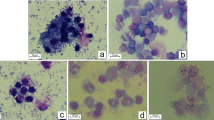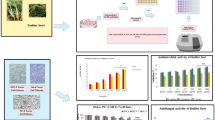Abstract
Centaurea species of Asteraceae family are widely use in traditional medicine. Despite wide medicinal use of Centaurea sp., there is limited knowledge concerning Centaurea behen toxicity. Therefore, in this study, it is aimed to determine cytotoxic and oxidative effects of essential oil of C. behen on human blood cell cultures. 3-(4,5-dimethylthiazol-2-yl)-2,5 diphenyltetrazolium bromide (MTT) and lactate dehydrogenase (LDH) release assays were performed to determine cytotoxic effects. In addition, total antioxidant capacity (TAC) and total oxidative status (TOS) were examined to determine oxidative potentials. The results indicated that all tested concentrations of essential oil of C. behen were cytotoxic and led to decreases of cell viability in both assays. Besides, C. behen led to significant increases of TOS levels and decreases of TAC levels. As a conclusion, the present study showed for the first time the cytotoxic and oxidant effects of essential oil of C. behen on cultured human whole blood cells.


Similar content being viewed by others
References
Al-Easa HS, Rizk AM (1992) Constituents of Centaurea species. Qatar Univ Sci J 12:27–57
Bach SM, Fortuna MA, Attarian R, de Trimarco JT, Catalán CA, Av-Gay Y, Bach H (2011) Antibacterial and cytotoxic activities of the sesquiterpene lactones cnicin and onopordopicrin. Nat Prod Commun 6:163–166
Çelik K, Toğar B, Turkez H, Taşpınar N (2014) In vitro cytotoxic, genotoxic and oxidative effects of acyclic sesquiterpene farnesene. Turk J Biol 38:253–259
Chen H, Yoshioka H, Kim GS, Jung JE, Okami N, Sakata H, Maier CM, Narasimhan P, Goeders CE, Chan PH (2011) Oxidative stress in ischemic brain damage: mechanisms of cell death and potential molecular targets for neuroprotection. Antioxid Redox Signal 14:1505–1517
Chougule P, Pawar R, Limaye D, Joshi YM, Kadam V (2012) In-Vitro antioxidant activity of ethanolic extract of Centaurea behen. J Appl Pharm Sci 2:106–110
Chougule P, Yadunath J, Ashish J (2014) Protective effect of ethanol extract of Centaurea behen Linn in. carbon tetra chloride-induced hepatitis in rats. Int J Pharm Pharm Sci 6:197–200
Conforti F, Menichini F, Loizzo MR, Statti AG, Rapisarda A, Menichini F, Houghton PJ (2008) Antioxidant, a-amylase inhibitory and brine-shrimp toxicity studies on Centaurea centaurium L. methanolic root extract. Nat Prod Res 22:1457–1466
Csupor-Loffler B, Hajdu Z, Rethy B, Zupko I, Mathe I, Redei T, Falkay G, Hohmann J (2009) Antiproliferative activity of Hungarian asteraceae species against human cancer cell lines. Part II. Phytother Res 23:1109–1115
Davis PH, Mill RR, Tan K (1988) Flora of Turkey and the east aegean islands. Edinburgh University Press, Edinburg
Duan X, Wen Z, Shen H, Shen M, Chen G (2016) Intracerebral hemorrhage, oxidative stress, and antioxidant therapy. Oxid Med Cell Longev. https://doi.org/10.1155/2016/1203285
Erel SB, Karaalp C, Bedir E, Kaehlig H, Glasl S, Khan S, Krenn L (2011) Secondary metabolites of Centaurea calolepis and evaluation of cnicin for anti-inflammatory, antioxidant, and cytotoxic activities. Pharm Biol 49:840–849
Erel SB, Demir S, Nalbantsoy A, Ballar P, Khan S, Karabay Yavasoglu NU, Karaalp C (2014) Bioactivity screening of five Centaurea species and in vivo anti-inflammatory activity of C. athoa. Pharm Biol 52:775–781
Erol-Dayi Ö, Pekmez M, Bona M, Aras-Perk A, Arda N (2011) Total phenolic contents, antioxidant activities and cytotoxicity of three Centaurea species: C. calcitrapa subsp. calcitrapa, C. Ptosimopappa and C. spicata. Free Radic Antioxid 1:31–36
Escher GB, Santos JS, Rosso ND, Marques MB, Azevedo L, Vieira do Carmo AM, Daguer H, Molognoni L, Do Prado-Silva L, Sant’Ana AS, Da Silva MC, Granato D (2018) Chemical study, antioxidant, anti-hypertensive, and cytotoxic/cytoprotective activities of Centeurea cyanus L. petals aqueous extract. Food Chem Toxicol 118:439–453
Esmaeili A, Khodadadi E (2012) Volatile compounds of essential oil Centaurea behen L. grown in Iran. J Paramed Sci 3:8–11
Evans HJ, O’Riordan ML (1975) Human peripheral blood lymphocytes for the analysis of chromosome aberrations in mutagen tests. Mutat Res 31:135–148
Flamini G, Stoppelli G, Morelli I, Ertugrul K, Dural H, Tugay O, Demirelma H (2004) Secondary metabolites from Centaurea isaurica from Turkey and their chemotaxonomical significance. Biochem Systemat Ecol 32:553–557
Funk VA, Bayer RJ, Keeley S, Chan R, Watson L, Gemeinholzer B, Schilling E, Panero JL, Baldwin BG, Garcia- Jacas N, Susanna A, Jansen RK (2005) Everywhere but Antarctica: using a super tree to understand the diversity and distribution of the Compositae. Biol Skr 55:343–374
Garcia-Jacas N, Susanna A, Mozaffarian V, Ilarslan R (2000) The natural delimitation of Centaurea (Asteraceae: Cardueae): ITS sequence analysis of the Centaurea jacea group. Plant Systemat Evol 223:185–199
Geyikoğlu F, Turkez H (2006) Protective effect of sodium selenite against the genotoxicity of aflatoxin B-1 in human whole blood cultures. Braz Arch Biol Technol 49:393–398
Geyikoğlu F, Turkez H, Keles MS (2005) The role of fruit juices in the prevention of aluminum sulphate toxicity in human blood in vitro. Fresenius Environ Bull 14:878–883
Gonzalez AG, Barrera JB, Garcia TZ, Rosas FE (1984) Sesquiterpene lactones from Centaurea species. Phytochemistry 23:2071–2072
Granato D, Calado VMA, Jarvis B (2014) Observations on the use of statistical methods in food science and technology. Food Res Int 55:137–149
Hussain SM, Hess KL, Gearhart JM, Geiss KT, Schlager JJ (2005) In vitro toxicity of nanoparticles in BRL 3A rat liver cells. Toxicol In Vitro 19:975–983
Karamenderes C, Khan S, Tekwani BL, Jacob MR, Khan IA (2006) Antiprotozoal and antimicrobial activities of Centaurea species growing in Turkey. Pharm Biol 44:534–539
Kaskoos RA (2013) In-vitro a-glucosidase inhibition and antioxidant activity of methanolic extract of Centaurea calcitrapa from Iraq. Am J Essent Oils Nat Prod 1:122–125
Kilic O (2013) Essential oil compounds of three Centaurea L. taxa from Turkey and their chemotaxonomy. J Med Plants Res 7:1344–1350
Kubacey TM, Haggag EG, El-Toumy Sayed AA, El-A Amany A, Ibrahim M, Youns MM (2012) Biological activity and flavonoids from Centaurea alexanderina leaf extract. J Pharm Res 5:3352–3361
Kurian A, Sankar A (2007) Medicinal plants. Horticulture Science Series. New India Publishing, New Delhi
Lau A, Wang Y, Chiu JF (2008) Reactive oxygen species: current knowledge and applications in cancer research and therapeutic. J Cell Biochem 104:657–667. https://doi.org/10.1002/(ISSN)1097-4644
Lewerenz V, Hanelt S, Nastevska C, El-Bahay C, Rouhrdanz E, Kahl R (2003) Antioxidants protect primary rat hepatocyte cultures against acetaminophen-induced DNA strand breaks but not against acetaminophen-induced cytotoxicity. Toxicology 191:179–187
López-Rodriguez M, Garcia VP, Zater H, Benayache S, Benayache F (2009) Cynaratriol, a sesquiterpene lactones from Centaurea musimomum. Acta Cryst E65:867–868
Medjroubi K, Benayache F, Bermejo J (2005) Sesquiterpene lactones from Centaurea musimomum. Antiplasmodial and cytotoxic activities. Fitoterapia 76:744–745
Mishio T, Honma T, Iwasshina T (2006) Yellow flavonoid in Centaurea ruthenica as flower pigments. Biochem Systemat Ecol 34:180–184
Newman DJ, Cragg GM (2016) Natural products as sources of new drugs from 1981 to 2014. J Nat Prod 79:629–661
Pires Tania CSP, Dias MI, Barrosa L, Calhelhaa RC, Alves MJ, Oliveira M, Beatriz PP, Buelga CS, Ferreira Isabel CFR (2018) Edible flowers as sources of phenolic compounds with bioactive potential. Food Res Int 105:580–588
Sarker SD, Savchenko T, Whiting P, Sik V, Dinan LN (1997) Moschamine, cis-moschamine, moschamine, moschamindole and moschamindolol: four novel indole alkaloids from Centaurea moschata. Nat Prod Lett 9:189–199
Seghiri R, Boumaza O, Mekkiou R, Benayache S, Mosset P, Quintana J, Estevez F, Leon F, Bermejo J, Benayache F (2009) A flavonoid with cytotoxic activity and other constituents from Centaurea africana. Phytochem Lett 2:114–118
Türkez H, Şişman T (2007) Anti-genotoxic effect of hydrated sodium calcium aluminosilicate on genotoxicity to human lymphocytes induced by aflatoxin b1. Toxicol Ind Health 23:83–89. https://doi.org/10.1177/0748233707076738
Ugur A, Duru ME, Ceylan O, Sarac N, Varol O, Kivrak I (2009a) Chemical composition, antimicrobial and antioxidant activities of Centaurea ensiformis Hub.-Mor. (Asteraceae), a species endemic to Muğla (Turkey). Nat Prod Res 23:149–167
Ugur A, Sarac N, Ceylan O, Duru ME (2009b) Chemical composition of endemic Centaurea austro-anatolica and studies of its antimicrobial activity againstmulti-resistant bacteria. Acta Pharm 59:463–472
Ugur A, Sarac N, Ceylan O, Duru ME (2010) Antimicrobial activity and chemical composition of endemic Centaurea cariensis subsp. niveo-tomentosa. Nat Prod Res 24:861–872
Uzunhisarcıklı ME, Teksen M, Dogan E (2005) Centaurea marashica (Asteraceae) a new species from Turkey. Ann Bot Fenn 42:309–312
Wang T, Jiang A, Zhang J, Jing F (2010) Apoptosis induction by E2F decoy DNA of the prostate cancer cell line. Braz Arch Biol Technol 53:327–334
Yeum K-J, Russell MR, Krinsky IN, Adlini G (2004) Biomarkers of antioxidant capacity in hydrophilic and lipophilic compartments of human plasma. Arch Biochem Biophys 430:97–103
Author information
Authors and Affiliations
Corresponding author
Ethics declarations
Conflict of interest
No potential conflict of interest was reported by the authors.
Additional information
Publisher's Note
Springer Nature remains neutral with regard to jurisdictional claims in published maps and institutional affiliations.
Rights and permissions
About this article
Cite this article
Çelikezen, F.Ç., Hayta, Ş., Özdemir, Ö. et al. Cytotoxic and antioxidant properties of essential oil of Centaurea behen L. in vitro. Cytotechnology 71, 345–350 (2019). https://doi.org/10.1007/s10616-018-0290-9
Received:
Accepted:
Published:
Issue Date:
DOI: https://doi.org/10.1007/s10616-018-0290-9




